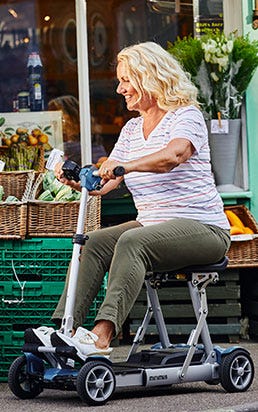If you’ve just bought a CareCo mobility scooter, congratulations. We hope you have many years of happy use with your new vehicle. Some are suitable for driving on the road and can travel at 8mph. You’re probably wondering what you can and cannot do on your vehicle, the law, licensing and a multitude of other legal requirements. While some laws apply equally to cars and your mobility scooter, there are also a number of differences. Let us explain the key differences and your rights and responsibilities.
Road Use
Your CareCo mobility scooter is either a Class 2 or a Class 3 vehicle. The main way to tell the difference is in the top speed. A Class 2 model has a speed limit of 4mph; you must not drive this vehicle on the road except where there is no choice – short stretches of road without a pavement, for example. A Class 3 vehicle may travel on the road and at 8mph. You are also permitted to drive these vehicles on pavements and in pedestrianised areas but you must limit the vehicle to 4mph when doing so. Class 3 CareCo mobility scooters must not use bus lanes or cycle lanes. As with other low-speed vehicles, you will not be permitted on dual carriageways where the speed limit is over 50mph. This includes motorways. On busy roads, your Class 3 vehicle must have the amber flashing light activated.
Licensing and Insurance
You don’t need a license to ride a CareCo mobility scooter. Therefore, if you never learnt to drive a motorcycle or a car, you won’t need to learn now – even for vehicle types that can go on the road. You will need to register your vehicle with the DVLA if it is a Class 3 mobility scooter. If you did not previously pass your driving test, it’s strongly recommended that you familiarise yourself with The Highway Code. This explains your rights, regulations and procedures of how to act on the road. Insurance is not a legal requirement, but it may be advisable to purchase an insurance policy. Should you run into a person or a vehicle, you will be liable for damages and repairs. Check out the range of CareCo mobility scooter insurance for some affordable options.
Where / How to Park
As with any other vehicle, you must not park your CareCo mobility scooter anywhere that it may cause an obstruction. Just as you mustn’t drive on a cycle path, you should not park on one either. Footpaths are a no-no, especially on a busy road that forces other users to go into the road to get around your vehicle. Always use a common sense approach. Supermarkets will sometimes have a designated parking area; you may be permitted to park in a disabled parking space. Always check with the premises you’re visiting before parking up.
Drink Driving
In a test case in 2016, a man driving a mobility scooter was breathalysed and charged with drink driving. In a car, you will lose your license for being over the limit. However, a mobility scooter is a disability aid – not a luxury. The breathalysed man pleaded guilty in court but it brought up a long list of questions in how to class mobility scooters and whether certain laws apply. The conviction was overturned following a review. Alcohol dulls the senses and reduces reaction times. This can lead to accidents, damage to property and injury to the user and others. There is no legal alcohol limit for driving a mobility scooter, but common sense is recommended when operating such a vehicle. Do not drink to the extent that your reactions are impaired or where there is a higher risk of injury or damage. As discussed above, insurance is strongly recommended too.


 Price Match Promise
Price Match Promise
 Next day delivery, 7 days a week
Next day delivery, 7 days a week
 Nationwide Showrooms
Nationwide Showrooms
 Rated Excellent
Rated Excellent







